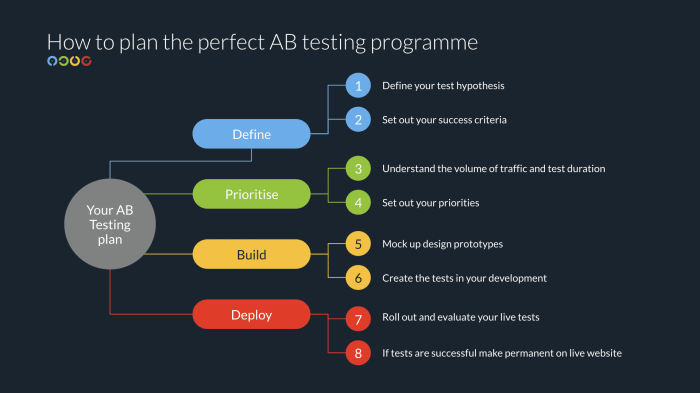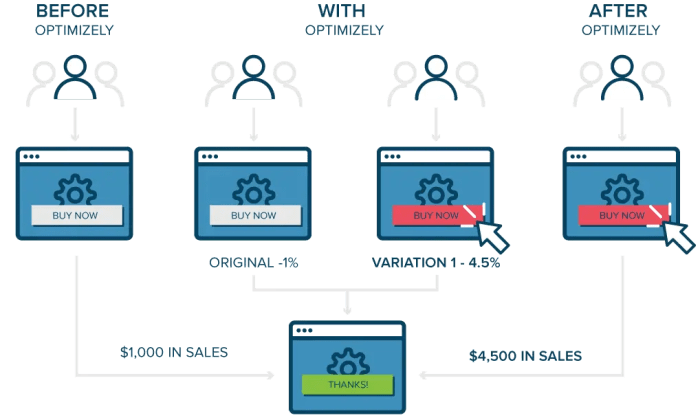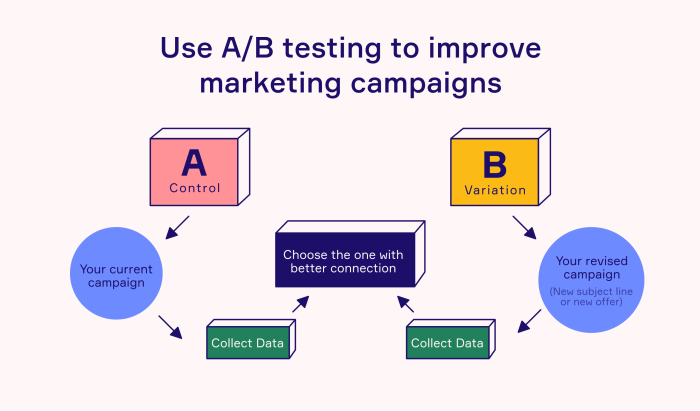
Implementing A/B testing for marketing optimization introduces a powerful tool to revolutionize marketing strategies and boost conversion rates. Dive into the world of A/B testing to uncover its impact on customer engagement and successful campaigns.
Importance of A/B Testing in Marketing Optimization: Implementing A/B Testing For Marketing Optimization

A/B testing plays a crucial role in optimizing marketing strategies by allowing businesses to experiment with different variations of their marketing campaigns to determine which one performs better. This data-driven approach helps in making informed decisions to enhance overall marketing effectiveness.
Improving Conversion Rates
A key aspect of A/B testing is its ability to improve conversion rates. By testing different elements such as call-to-action buttons, headlines, images, or pricing strategies, marketers can identify the most effective combination that drives higher conversions. This leads to increased sales, leads, or any desired action from the target audience.
- A study by HubSpot found that A/B testing on call-to-action buttons resulted in a 121% increase in clicks for the winning variation, showcasing the impact of small changes on conversion rates.
- In another example, Airbnb used A/B testing to optimize their landing page design, leading to a 20% increase in conversions, demonstrating the power of data-driven decision-making in improving marketing performance.
Enhancing Customer Engagement
A/B testing also plays a vital role in enhancing customer engagement by testing different content formats, messaging tones, or personalized recommendations. This helps in delivering a more tailored and engaging experience to the target audience, ultimately increasing customer loyalty and satisfaction.
A/B testing allows businesses to understand what resonates with their audience and tailor their marketing strategies accordingly, leading to more impactful and engaging campaigns.
Setting Up A/B Tests
Setting up A/B tests for marketing purposes involves a systematic approach to comparing two versions of a marketing asset to determine which one performs better. Below are the steps involved in setting up an A/B test for marketing optimization:
Defining Objectives and Hypotheses
To begin, it is crucial to define clear objectives for the A/B test. This involves identifying what specific metrics or key performance indicators (KPIs) you want to improve through the test. Additionally, formulating hypotheses is essential to establish what you expect to achieve with each version of the marketing asset.
- Clearly Artikel the primary objective of the A/B test, such as increasing click-through rates or improving conversion rates.
- Develop hypotheses for each version of the marketing asset, stating the expected outcomes based on changes made.
- Ensure that objectives and hypotheses are measurable and specific to facilitate accurate data analysis.
Selecting Variables to Test
When setting up an A/B test, it is important to carefully select the variables to test in the experiment. These variables can include elements such as headlines, call-to-action buttons, images, or overall layout.
- Identify the key components of the marketing asset that are likely to impact the desired outcome.
- Choose variables that are distinct and have the potential to influence user behavior significantly.
- Avoid testing too many variables simultaneously to maintain clarity and ensure conclusive results.
Importance of Sample Size Calculation
Sample size calculation plays a vital role in the accuracy and reliability of A/B testing results. Determining the appropriate sample size is crucial for ensuring that the test has enough statistical power to detect meaningful differences between the variations.
Calculating sample size involves considering factors such as desired confidence level, statistical significance, expected effect size, and baseline conversion rate.
- Conduct sample size calculations before launching the A/B test to determine the number of participants needed for each variation.
- Ensure that the sample size is sufficient to detect significant differences between the versions being tested.
- Regularly monitor the sample size during the test to account for any dropouts or deviations that may affect the validity of the results.
Implementing A/B Tests

Implementing A/B tests on different marketing channels involves a systematic process to compare two versions of a marketing element to determine which one performs better. Here is how to effectively implement A/B tests in your marketing strategy:
Process of Implementing A/B Tests on Different Marketing Channels
- Identify the marketing element to test: Start by selecting a specific element such as ad copy, email subject lines, landing page design, or call-to-action button.
- Create variations: Develop two versions of the selected element, ensuring they differ only in one variable to accurately measure the impact of the change.
- Randomize the audience: Split your audience randomly into two groups, with each group exposed to one version of the element.
- Run the test: Monitor the performance of each version by tracking relevant metrics such as click-through rates, conversion rates, and engagement levels.
- Analyze results: Compare the performance of both versions to determine the winning variant based on statistical significance.
- Implement changes: Apply the insights gained from the A/B test to optimize future marketing campaigns.
Best Practices for Running Simultaneous A/B Tests, Implementing A/B testing for marketing optimization
- Avoid overlapping test periods: Ensure that A/B tests on different marketing channels do not run concurrently to prevent interference and inaccurate results.
- Set clear goals: Define specific objectives for each A/B test to focus on the key metrics that align with your marketing goals.
- Segment your audience: Tailor A/B tests to specific audience segments to gain insights into how different customer groups respond to variations.
- Document your tests: Keep detailed records of each A/B test, including test variables, audience segments, results, and conclusions for future reference.
Ensuring Randomization and Control in A/B Testing Procedures
- Use A/B testing tools: Leverage specialized software like Google Optimize, Optimizely, or VWO to automate the A/B testing process and ensure randomization.
- Randomize sample selection: Randomly assign participants to different test groups to eliminate bias and ensure statistical validity.
- Control external factors: Minimize external variables that could influence test results by conducting tests in controlled environments.
- Statistical significance: Ensure that A/B test results are statistically significant to make informed decisions based on reliable data.
Tools and Software Options for Implementing A/B Tests
- Google Optimize: A free tool by Google that allows you to create and run A/B tests on websites.
- Optimizely: A popular A/B testing platform that offers advanced features for optimizing marketing strategies.
- VWO (Visual Website Optimizer): A comprehensive testing tool that provides insights into user behavior and engagement.
- Crazy Egg: A heatmap tool that helps visualize user interactions on web pages, aiding in optimization decisions.
Analyzing A/B Test Results
Once the A/B test has been conducted and data collected, it is crucial to analyze the results to draw meaningful insights and make informed decisions for marketing optimization.
Methods for Analyzing and Interpreting A/B Test Results
- Calculate key metrics: Compare conversion rates, click-through rates, bounce rates, and other relevant metrics for the control and variant groups.
- Statistical significance: Utilize statistical tools like t-tests or chi-squared tests to determine if the differences in performance between the two groups are statistically significant.
- Data visualization: Use graphs, charts, and tables to visualize the results and identify trends or patterns.
- Segment analysis: Break down the results by different segments (e.g., demographics, geography) to understand how different audience groups respond to the changes.
Identifying Statistically Significant Outcomes in A/B Testing
- Confidence level: Look for results with a high confidence level (typically 95% or higher) to ensure that the observed differences are not due to random chance.
- P-value: Pay attention to the p-value, which indicates the probability of obtaining results as extreme as the ones observed if there is no real difference between the groups.
- Sample size: Ensure that the sample size is large enough to detect meaningful differences and avoid drawing conclusions based on small sample sizes.
Key Metrics to Consider when Evaluating A/B Test Results
- Conversion rate: Measure the percentage of users who take a desired action, such as making a purchase or signing up for a newsletter.
- Revenue per visitor: Calculate the average revenue generated per visitor to determine the impact on the bottom line.
- Engagement metrics: Analyze metrics like time on site, pages per visit, and bounce rate to understand user behavior and satisfaction.
- Retention rate: Evaluate how many users return to the site or app after the initial visit to assess long-term impact.
Importance of Iterative Testing and Continuous Optimization
- Iterative improvement: Use the insights from A/B testing to make incremental changes and continuously refine marketing strategies for better results.
- Continuous optimization: Implement a culture of testing and optimization to adapt to changing market conditions and consumer preferences.
- Data-driven decision-making: Base marketing decisions on data and experiment results rather than assumptions or gut feelings to drive growth and success.
Wrap-Up

In conclusion, Implementing A/B testing for marketing optimization opens new avenues for refining marketing tactics and achieving better results. Embrace the power of A/B testing to drive continuous improvements and success in your marketing endeavors.
Digital marketing strategies are crucial for small businesses looking to expand their online presence. By utilizing various digital platforms and tools, businesses can reach a wider audience and increase brand awareness. One effective strategy is to incorporate geotargeting into marketing efforts, allowing businesses to target specific locations and tailor their messages accordingly.
For best practices in multi-channel marketing campaigns, businesses can learn how to effectively integrate different channels such as social media, email, and websites to create a cohesive marketing strategy. To learn more about these strategies, check out this article on Digital marketing strategies for small businesses.
Small businesses can benefit greatly from implementing effective digital marketing strategies to reach a wider audience and increase brand awareness. By utilizing social media platforms, email marketing, and search engine optimization, small businesses can compete with larger corporations in the online space.
When it comes to running successful marketing campaigns, incorporating best practices for multi-channel marketing is essential. This involves coordinating efforts across various channels such as social media, email, and mobile to create a cohesive and impactful campaign that reaches customers wherever they are.
For small businesses looking to target local customers, utilizing geotargeting can be a game-changer. By tailoring marketing efforts based on the location of the target audience, businesses can increase relevance and engagement, leading to higher conversion rates and customer loyalty.









